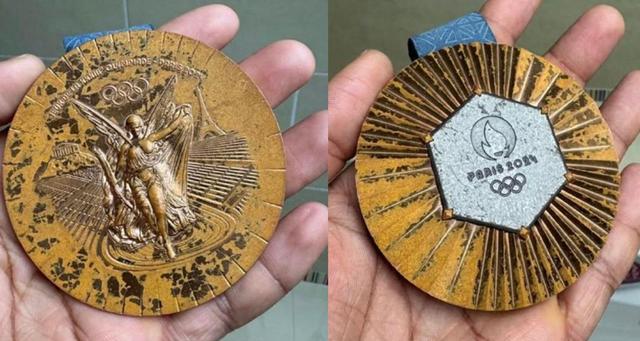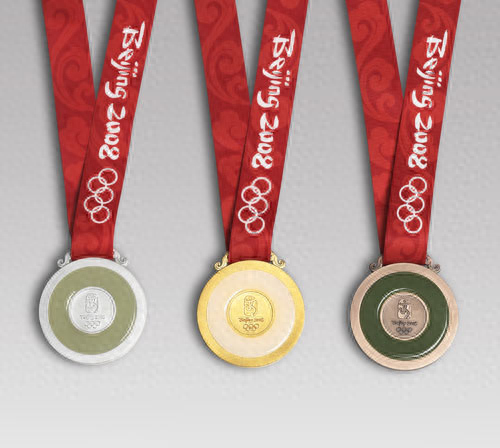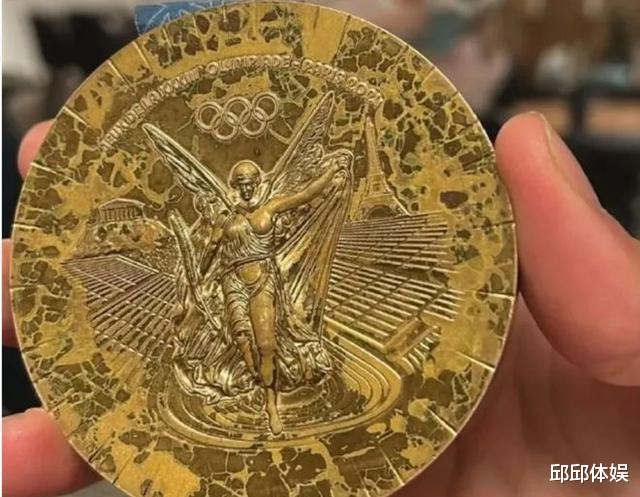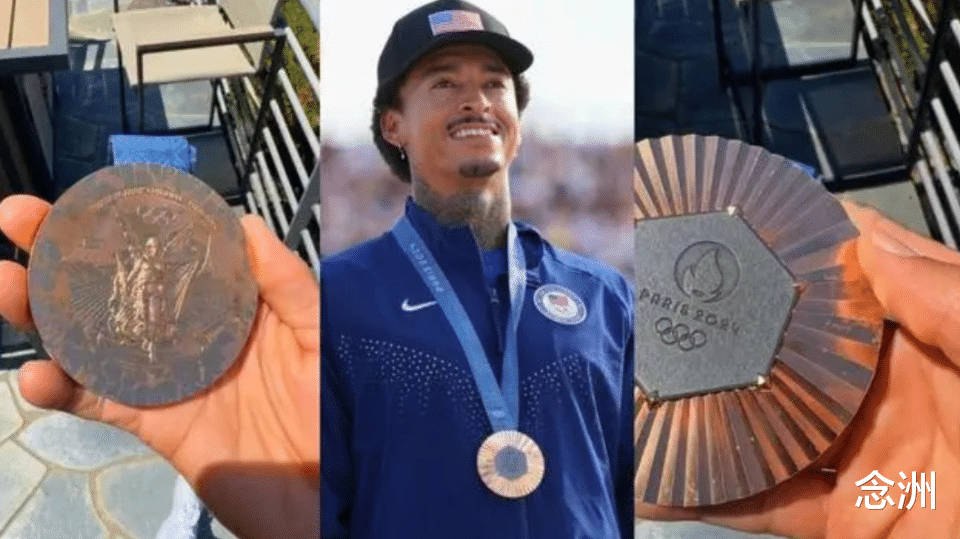It was unexpected that the "Gold-inlaid Jade" medals from the 2008 Beijing Olympics would return to the public eye in such a unique way. Recently, news of about 100 Paris Olympic medals being returned due to severe oxidation has caused quite a stir, which is a significant embarrassment for any Olympic Games. Athletes train hard for years and strive to bring back Paris Olympic medals to their countries, only to find that Paris Olympics have arranged a "defective product" for them, which is truly speechless. This is not the first time the Paris Olympics have reported problems with medal quality. During the Paris Olympics, athletes who had just received their medals noticed that the quality seemed unsatisfactory. Subsequently, more athletes posted that their Paris Olympic medals also showed signs of wear and discoloration, giving the impression that the medals were not as good as they should be, but rather rough. An athlete who also won a medal at the Paris Olympics even shared his "battle-damaged medal," which looked so worn out in the photo that it was barely recognizable. He even jokingly compared this Olympic medal to an "antique relic" of a century-old object, which made him somewhat tearful. This also reminds people of the "accidentally trending" gold-inlaid jade medal from the 2008 Beijing Olympics. In 2021, Russian rhythmic gymnast Daria accidentally started a fire by lighting a candle at home. Although she and her cat were safe, the house was burned beyond recognition. However, amidst the wreckage, something shiny caught Daria's attention, and when she picked it up, it…
Embarrassing! 100 Paris Olympic Medals Returned, Beijing Olympic Gold-inlaid Jade's Gold Content Still Rising
Embarrassing! Over 100 Paris Olympic Medals Returned, While the Gold Content of Beijing's "Gold-inlaid Jade" Medals Continues to Rise The French Olympics, which have already concluded, continue to be a source of embarrassment. In contrast, the "gold-inlaid jade" medals from China's 2008 Beijing Olympics have returned to public attention in a unique way, with the "gold content" of these medals still on the rise. For the performance of the medals at the Paris Olympics in France, one can't help but question whether it is appropriate to do so for the sake of "environmental protection." Now, more than 100 Olympic medals have been returned... The "gold-wrapped iron" that is embarrassing As the world's largest comprehensive sports event, it not only showcases the style of athletes but also tests the strength of the host country. However, over 100 medals have now appeared with serious oxidation and have been returned by the athletes, which is undoubtedly a slap in the face for France. The Olympic gold medal, as the highest honor in the sports world, carries the efforts and struggles of countless athletes. However, the initial champions actually received silver medals instead of gold medals. Since Pierre de Coubertin founded the modern Olympic Games in 1896, the first modern Olympics was held in Athens, Greece. Gold was considered inconsistent with the ancient Olympic spirit, so only the top two finishers in each event could receive medals, that is, silver and bronze medals. The first gold medal was actually born at the third Olympics held in the United States in 1904. It was the…
Shameful! 100 Paris Olympic Medals Returned, Beijing Olympic Gold Medals' Value Continues to Rise!
It is a shame that 100 medals from the Paris Olympics have been returned due to severe discoloration and oxidation issues. This news has caused widespread mockery from around the world. The medals were made primarily of recycled metals, which are less stable and more prone to oxidation. Additionally, the paint used on the medals was changed for environmental reasons, but this new paint had not been adequately tested, leading to further problems. The Paris Organizing Committee's focus on environmentalism may have come at the cost of medal quality, disappointing athletes who worked hard to earn them. In contrast, the gold medals from the Beijing Olympics, known for their "gold inlay jade," continue to maintain their value and quality. These medals were designed with durability in mind, featuring an invisible protective layer that prevents damage from falls or wear. Even the ribbons on the medals are crafted with unique Chinese techniques, as evidenced by a Russian athlete whose Beijing Olympic medal survived a house fire unscathed. The attention to detail and commitment to quality in the Beijing Olympics reflect the Chinese spirit of craftsmanship and dedication to excellence.
Two days ago, a news story about the Paris Olympic medals topped the trending list, quickly sparking heated discussions among netizens. Olympic medals are supposed to be symbols of infinite honor, yet over 100 have been returned to Paris in disgrace. Some jokingly said that the bronze medal they received resembled a piece of "crocodile skin." Others were more supportive, claiming it wasn't a medal but a hundred-year-old Parisian antique. This caused netizens to exclaim that Paris has truly embarrassed itself this time, with the shame spreading globally. So why are so many medals being returned? If there's anything that can validate an athlete's efforts and achievements, Olympic medals are undoubtedly the most powerful proof. When once-celebrated athletes find themselves in trouble, medals can also serve as a quick way to make money. Athletes who have fought hard for their honors on the field return home only to find their medals rusted. This makes most athletes feel very uncomfortable, leading some to return their rusted medals. This isn't the first time this has happened; soon after the Olympics ended, people started returning their medals. By the 13th, British newspapers reported that over 100 gold medals had been returned. The next day, the international Olympic Committee addressed the issue, stating that all problematic medals would be replaced. Last August, French athletes noticed this phenomenon shortly after receiving their medals, saying they looked "smashed and oxidized." Some medals even began discoloring before the Olympics concluded. Harper mentioned that her bronze medal had lost its luster and was starting to fade. When the…
Embarrassing! 100 Paris Olympic Medals Returned, China's Gold-inlaid Jade Medals Continue to Increase in Value
In the eyes of every professional athlete, reaching the Olympic stage is the ultimate goal, and winning a medal in the Olympic competition is seen as the pinnacle moment of their career. However, recently, many athletes who won medals at the Paris Olympics are finding it hard to be joyful. On January 14th, news that over 100 Paris Olympic medals were returned quickly trended on social media, leaving many netizens surprised: Why would these athletes, who worked so hard to win medals, have them taken back half a year later? In fact, the decision to recall the medals was not the original intention of the French Olympic Committee; it was only after many athletes voiced their concerns that France agreed to take back the medals. As early as mid-August 2024, American skateboarder Houston, who won a bronze medal, posted a video online claiming that just ten days after receiving the medal, its condition had significantly deteriorated, with the plating starting to peel off and the surface looking dull. Subsequently, a member of the French relay swimming team also shared their bronze medal online, finding that its condition was even worse than Houston's, with severe oxidation and paint peeling, leading netizens to jokingly compare it to "crocodile skin" or a newly unearthed "ancient relic" from Paris, but it was hard to believe this was a medal won just half a year ago. In fact, two weeks after the opening of the Paris Olympics, the organizers knew there might be issues with the medals. Irish rower Lynch revealed that his medal was…
Translation of the article title into English: "Up to 100 Paris Olympic Medals Returned, Paris Organizing Committee Responds
Recently, foreign media reported a shocking news: as many as 100 medals were returned by athletes during the 2024 Paris Olympics. These medals, which should have been symbols of the hard work and heroic efforts of the athletes on the field, are now controversial due to quality issues. This incident has quickly attracted widespread attention and heated discussion around the world, not only casting a shadow over the image of the Paris Olympics but also raising deep doubts about the production and quality of the medals. During the Olympics, some athletes complained about the quality of the medals on social media. French swimmers Clementine Seguin and John N'Doye-Brouard posted photos of their bronze medals after winning, joking about their severe oxidation. The medals in the photos were covered with mottled rust marks, as if they had been washed by the vicissitudes of time, forming a stark contrast with the Olympics that had just ended not long ago. Clementine Seguin even described the medal as being like "crocodile skin," rough and dull, lacking the solemnity and holiness that an Olympic medal should have. As time went on, more and more athletes found similar problems with their medals. American skateboarder Nyjah Huston posted on social media less than 10 days after the Paris Olympics ended, complaining that his bronze medal was already rusted. He helplessly expressed that the medal looked like a veteran who had gone through countless battles and had lost its former glory. Nyjah Huston's complaint quickly resonated with netizens, who all expressed disappointment and dissatisfaction with the quality of…
Embarrassing! 100 Paris Olympic Medals Returned Due to Oxidation, While Beijing's Gold-inlaid Jade Medals Maintain Their Value
On January 13th, Beijing time, according to French media reports, about 100 medals from the Paris Olympics were returned by athletes due to rapid oxidation of their appearance. It is truly speechless that such prestigious Olympic medals have experienced severe quality issues, which has undoubtedly dampened the spirits of the medal recipients. The French media revealed that at least 15 months ago, even before the start of the Paris Olympics, the medals had been plagued with defective varnish problems that remained unresolved. Last August 8th, American skateboarder Nyjah Huston openly complained that within just ten days of receiving his Olympic bronze medal, its condition deteriorated to the point of being unrecognizable, with a dull surface and noticeable rust and black spots. In December last year, two French swimmers showcased their Olympic bronze medals on social media. Despite the Olympics having ended only a few months prior, these medals were already in a state of disrepair. Brouard wrote, "Paris 1924," suggesting that the medal looked like it was from a century ago. His teammate Seki described his bronze medal as looking like "crocodile skin." Currently, approximately 100 Paris Olympic medals have been returned by athletes due to rapid oxidation. Although the International Olympic Committee (IOC) has assured that the medals will be replaced, this situation is indeed embarrassing. In contrast, the "Gold-inlaid Jade" medals from the Beijing Olympics are still well-preserved, indestructible by fire or impact, and their value continues to rise when compared to others.
Olympic Medals Rusting After Just 3 Months: Athletes Speak Out on Paris Olympics' Quality Concerns
It is well-known that the medals of the Paris Olympics are touted for their emphasis on environmental protection and sustainable development, while also showcasing France's profound cultural heritage. However, more importantly, there is a lack of funding. In terms of material and cost, the Paris Olympics have set a new low. According to the medal production process of the Paris Olympics released by Oxford Economics ↓↓↓ Gold Medal: Mainly made of about 523 grams of pure silver, with an outer layer of 6 grams of pure gold plating, weighing approximately 529 grams in total. According to estimates by the Oxford Economics Institute, the material value of each gold medal is about $1027. Silver Medal: Entirely crafted from about 525 grams of pure silver, with a material value of about $535. Bronze Medal: Weighing about 455 grams, made of an alloy of copper, tin, and zinc, with a material value of about $4.6. The official Olympic website reports that at the center of each medal is embedded a hexagonal piece of iron taken from the original ironwork of the Eiffel Tower, symbolizing France's cultural heritage. These iron pieces have been meticulously polished to restore their original color and printed with the emblem of the Paris Olympics. The front design of the medal features radiant lines surrounding the central iron piece, echoing Paris' reputation as the "City of Light." Additionally, the production of the medals adheres to the regulations of the International Olympic Committee, ensuring that their size and quality meet the standards. However, it turns out that the rust from the…







